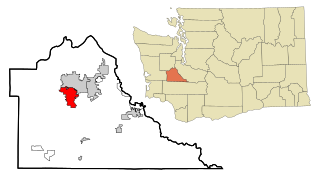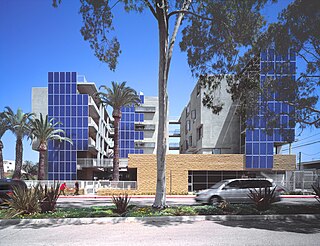
Thurston County is a county located in the U.S. state of Washington. As of the 2020 census, its population was 294,793. The county seat and largest city is Olympia, the state capital.

Lewis County is a county in the U.S. state of Washington. As of the 2020 census, the county's population was 82,149. The county seat is Chehalis, and its largest city is Centralia. Lewis County comprises the Centralia, WA Micropolitan Statistical Area, which is also included in the Seattle-Tacoma, WA Combined Statistical Area.

Lacey is a city in Thurston County, Washington, United States. It is a suburb of Olympia with a population of 53,526 at the 2020 census, making it the 24th most populous city in Washington. Lacey is located along Interstate 5 between Olympia and the Nisqually River, which marks the border with Pierce County and Joint Base Lewis–McChord.

Tumwater is a city in Thurston County, Washington, United States. The population was 25,350 at the 2020 census. The city is situated near where the Deschutes River enters Budd Inlet, the southernmost point of Puget Sound; it also borders the state capital of Olympia to the north. Tumwater is the oldest permanent Anglo-American settlement on Puget Sound.

A tent city is a temporary housing facility made using tents or other temporary structures.

Dignity Village is a city-recognized legal encampment of an estimated 60 homeless people in Portland, Oregon, United States. In the days before Christmas of 2000, a group of individuals living outdoors in Portland established a tent city. It evolved from a group of self-described "outsiders" squatting a city owned land to a self-regulating, city-recognized campground as defined by Portland city code. The encampment is located on land near Portland International Airport, and has elected community officials and constructed crude but functional cooking, social, electric, and sanitary facilities.

Refugee shelters are structures ranging from the most temporary tent accommodation through transitional shelter to building temporary pics and settlements and include the most basic kind of ad hoc structure. They are created in the aftermath of a conflict or natural disaster as a temporary residence for victims who have lost or abandoned their homes. Refugees and IDPs are people fleeing their homes or countries of origin due to natural disasters, war and political or religious persecution in search of refuge and resettlement. Living in these shelters refugees may force marriage crowded, noisy, dirty, disease filled grounds where thousands of families are cramped together and surviving day by day.
Jack Tafari was a sometimes homeless Rastafari activist who advocated for himself and other homeless people, in the US and the UK. He was best known for promoting "sanctioned tent cities" as transitional housing for homeless people, including himself, in Portland, Oregon, United States.

The history of Olympia, Washington, includes long-term habitation by Native Americans, charting by a famous English explorer, settlement of the town in the 1840s, the controversial siting of a state college in the 1960s and the ongoing development of arts and culture from a variety of influences.

The tiny-house movement is an architectural and social movement promoting the reduction and simplification of living spaces. According to the International Residential Code, a tiny house’s floorspace is no larger than 400 square feet (37 m2). Proponents suggest that tiny homes could offer low-cost, eco-friendly alternatives within the housing market and serve as a transitional housing option for homeless individuals.

Colorado Court Housing is a 44-unit housing project designed by the architectural firm Pugh + Scarpa. Colorado Court is the first United States Green Building Council (USGBC) "LEED" certified multi-family housing project, achieving "Gold" certification. Located at the corner of a main offramp of the Santa Monica freeway, Colorado Court's highly visible position makes it gateway to the city of Santa Monica, California. The 44-unit, five-story building is the first affordable-housing project the United States to be LEED certified and is nearly 100% energy neutral (Colorado Court Movie Clip). This project is an excellent model of sustainable development in an urban environment, provides a model for private/public partnerships benefit the community, and promotes diversity in an urban environment through strategically placed affordable housing.

In the Seattle King County area, there were estimated to be 11,751 homeless people living on the streets or in shelters. On January 24, 2020, the count of unsheltered homeless individuals was 5,578. The number of individuals without homes in emergency shelters was 4,085 and the number of homeless individuals in transitional housing was 2,088, for a total count of 11,751 unsheltered people.
The Rudy Bruner Award for Urban Excellence (RBA) was established in 1986 by Cambridge, Massachusetts architect Simeon Bruner. The award is named after Simeon Bruner's late father, Rudy Bruner, founder of the Bruner Foundation. According to the Bruner Foundation, the RBA was created to increase understanding of the role of architecture in the urban environment and promote discussion of what constitutes urban excellence. The award seeks to identify and honor places, rather than people, that address economic and social concerns along with urban design.

The San Francisco Bay Area comprises nine northern California counties and contains five of the ten most expensive counties in the United States. Strong economic growth has created hundreds of thousands of new jobs, but coupled with severe restrictions on building new housing units, it has resulted in a statewide housing shortage which has driven rents to extremely high levels. The Sacramento Bee notes that large cities like San Francisco and Los Angeles both attribute their recent increases in homeless people to the housing shortage, with the result that homelessness in California overall has increased by 15% from 2015 to 2017. In September 2019, the Council of Economic Advisers released a report in which they stated that deregulation of the housing markets would reduce homelessness in some of the most constrained markets by estimates of 54% in San Francisco, 40 percent in Los Angeles, and 38 percent in San Diego, because rents would fall by 55 percent, 41 percent, and 39 percent respectively. In San Francisco, a minimum wage worker would have to work approximately 4.7 full-time jobs to be able to spend less than 30% of their income on renting a two-bedroom apartment.

In 2016, a report from the Department of Housing and Urban Development (HUD) revealed that the U.S. state of Oregon had an estimated homeless population of 13,238 with about 60.5% of these people still unsheltered. In 2017, these numbers were even higher. As of January 2017, Oregon has an estimated 13,953 individuals experiencing homelessness. Of this homeless population, 1,083 are family households, 1,251 are veterans, 1,462 are unaccompanied young adults, and 3,387 are individuals experiencing chronic homelessness. As of 2022, 17,959 people total experienced homelessness in Oregon, with 2,157 individuals being youth under 18, 6,671 being female, 10,931 being male, and 131 being transgender. Also among the 17,959 total homeless in 2022, 15,876 were Non-Hispanic/Non-Latino, 2,083 were Hispanic/Latino, 13,960 were white, 1,172 were Black, African American, or African, 101 were Asian or Asian American, 880 were Native American, and those of multiple race were 1,619. Oregon has seen an increase in its total homeless population consistently every year since 2010. In last three years specifically Oregon has seen a 98.5% increase 2021-2022, 22.5% increase 2020-2021, and a 13.1% increase 2019-2020.
Cheryl Lynne Selby is an American politician. She serves as the mayor of Olympia, Washington.
Pallet, established in 2016 and based in Everett, Washington, is a public benefit corporation focused on addressing unsheltered homelessness and improving employment opportunities. The company designs and manufactures rapid deployment shelters aimed at transitional housing to facilitate the move from homelessness to permanent living situations. These shelters prioritize privacy and security with features such as lockable doors and on-site bathroom facilities. Designed for quick assembly, each unit can be set up within an hour. Pallet also extends its efforts to provide emergency housing solutions and assist communities in disaster situations.
Opportunity Village is an organized homeless community in Eugene, Oregon. It is supported by the non-profit organization Opportunity Village Eugene (OVE).













